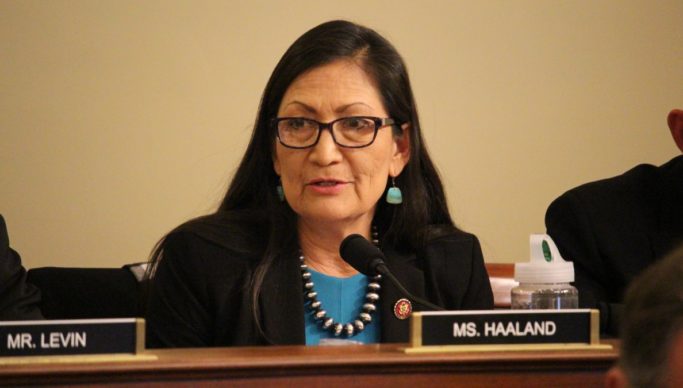
“What Kind of God Are You?” – Interior Secretary Deb Haaland’s Mission to Heal Indigenous People Targeted for Cultural and Spiritual Extinction
- By Deirdre Pelphrey --
- 19 Jul 2023 --
“For years I was not a person. My personhood was taken away.” Grace Smith, an 81-year-old Yup’ik originally from Pitkas Point, Alaska, was describing her experience as a little girl taken from her home and sent to Holy Cross boarding school, one of many such “schools” designed by the federal government in partnership with the Catholic Church between 1819 and 1969 with the express purpose of “civilizing” native peoples by denying them their language, culture and religion. All told, tens of thousands of children were torn from their families and physically abused for speaking their native tongue, for practicing their spiritual ceremonies, for anything deemed out of line.
“The nun said, ‘You’re speaking barbarian. Speak English.’ In boarding school, you’re not even a human being,” Smith continued, as Secretary of the Interior, Deb Haaland—the first Native American to serve as a cabinet secretary—listened quietly along with the other attendees that Saturday in June at a meeting called by the Mille Lacs Band of Ojibwe in Onamia, Minnesota.
“Sometimes, “I yell at God. ‘Why did I have to go through this? What kind of God are you?’” The meeting in which others shared their stories of violence and loss, is part of the Department of the Interior’s year-long Road to Healing Tour.
Secretary Haaland, silent for the greater part of the meetings, addressed survivors gathered at the sixth stop on the tour—Tulalip, Washington, the site of the Tulalip Indian School, one of at least 15 Indian boarding schools in that state begun in the 1860s. “My ancestors and many of yours endured the horrors of Indian boarding school. Assimilation policies carried out by the same department that I now lead,” she begins.
“I launched the Federal Indian Boarding School Initiative in 2021 to undertake a comprehensive effort to recognize the legacy of boarding school policies with the goal of addressing their intergenerational impacts and to shed light on the traumas of the past.”
Haaland (native name Crushed Turquoise) aims to provide indigenous survivors and their descendants the chance to make their experiences known.
At Tulalip, Matthew Warbonnet—for years denied the ability to speak his native Lakota—addressed the gathering in that tongue, and then translated in English. He gestured with an old belt as he told of how he and other children, taken from their homes, would cry at night. “Sometimes a priest who shared a little room off the side there would get disturbed about that. He would come out with his belt, pick up a kid off the bed, and whack them. For crying.” So saying, Warbonnet took the belt and savagely made the motion of beating someone. “‘Cause when you’re six years old and you see that, you get scared. You start holding things in.”
Paralleling the tour is an ongoing investigation, launched during the first year of Haaland’s tenure, which has identified more than 500 deaths in school burial sites. That number, however, as the department report notes, is projected to climb to “the thousands or tens of thousands.”
The century-and-a-half program was geared to ruin lives on an industrial scale, shatter Native families and create what Haaland deems “intergenerational trauma.” Graduates weren’t educated to prepare for upward mobility—girls were trained to sew and clean, starting with the schools—but to be mired in lifelong poverty. Along with poverty came its spawn—depression, alcoholism, drug addiction and broken communities.
Secretary Haaland, while acknowledging that she took over the Department of the Interior with a mission to help indigenous people reclaim their culture, their religion and their selfhood, understands that her position serves all Americans. “In a way, we’re also healing our country,” she says. “That history is American history. It affects every single American. It affects you whether you realize it or not.”
And to the survivors and their descendants on the tour she says, “I want you to know that I am with you on this journey and I will listen. I will grieve with you. I will weep and I will feel your pain.”



















